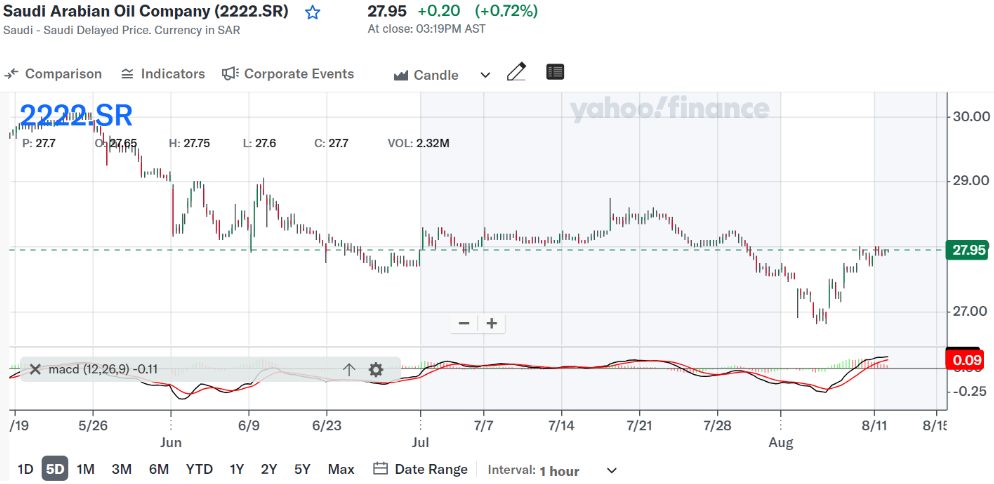Day Trading in Saudi Arabia



Day trading in Saudi Arabia is gaining traction. Significant disposable incomes, one of the region’s most liquid stock markets, and efforts to diversify its economy away from oil through initiatives like Vision 2030 are creating a dynamic financial environment with short-term trading opportunities.
Looking to start day trading in the Kingdom? This guide will equip you with the basics.
Quick Introduction
- The Saudi Capital Market Authority (CMA) regulates day trading activities and is a ‘yellow tier’ watchdog in line with DayTrading.com’s Regulation & Trust Rating. CMA guidelines include rules on transparency, market conduct, and leverage to protect investors.
- The Saudi Stock Exchange (Tadawul) was formed in 2007 and offers a wide range of trading options, including equities, Islamic bonds (sukuk), exchange-traded funds (ETFs), and mutual funds, with nearly 200 companies listed for trading.
- Unlike much of the world, Saudi Arabia’s Zakat, Tax and Customs Authority does not require traders to pay income tax or capital gains on profits from day trading activities.
Top 4 Brokers in Saudi Arabia
Following our in-depth tests and analysis, these 4 platforms reign as the best for day traders in the Kingdom:
All Day Trading Platforms in Saudi Arabia
What Is Day Trading?
Day trading is a high-risk trading strategy where financial instruments like stocks listed on the Tadawul, currencies like the Saudi Riyal (SAR), and commodities like oil are bought and sold within the same trading day. The aim is to profit from short-term price movements.
Day traders typically close all their positions by the end of the trading day to avoid holding any open positions overnight, limiting exposure to risks that may arise from after-hours news or events.
CFD trading in Saudi Arabia, like many countries, is attracting interest, providing a flexible vehicle to speculate on upward-downward price movements across various markets with leverage to magnify trading results (profit and loss).
Successful day traders in Saudi Arabia may use a variety of strategies to profit from market fluctuations. These include:
- Scalping: Making multiple small trades to profit from minute price changes.
- Momentum Trading: Capitalizing on trending securities with significant price movements.
- Technical Analysis: Using charts, indicators, and patterns to predict short-term price movements.
Is Day Trading Legal In Saudi Arabia?
Day trading is legal in Saudi Arabia. The activity is regulated by the Saudi Capital Market Authority (CMA), which oversees the Tadawul.
Active traders must comply with CMA regulations, including transparency, market conduct, and leverage rules. As long as traders operate within these guidelines, day trading is a permissible investment activity in the Kingdom.
In Saudi Arabia, margin trading (borrowing trading funds) is allowed, and traders must meet specific criteria set by their brokerage firm to use leverage.
Sukuk bonds are structured to comply with Islamic law, with no interest payments or underlying assets involved in haram activities.However, these Islamic bonds are generally less suitable for short-term trading owing to their fixed maturity dates, liquidity issues and relatively low volatility.
Is Day Trading Taxed In Saudi Arabia?
Day trading is not taxed in Saudi Arabia by the Zakat, Tax and Customs Authority. The Kingdom does not impose a capital gains tax on individuals, which includes profits earned from day trading.
This is similar to the stance taken in other Middle Eastern countries, including the UAE and Qatar, resulting in a tax-free environment that makes Saudi Arabia an attractive place for active traders.
However, Saudi traders should still consider other costs, such as brokerage commissions and market data charges when calculating net profits.
Getting Started
Getting started with day trading in Saudi Arabia involves several steps:
- Choose a top day trading broker in Saudi Arabia. Consider your needs as a short-term trader, for example, low transaction fees, fast execution, excellent charting tools, and access to the markets you’re interested in trading, whether Saudi stocks, currency pairs like the USD/SAR or key commodities like oil.
- Open an account. The account opening process normally takes about 30 minutes to provide basic contact details and information about your investment experience and source of funds. Then you’ll normally need to verify your identity and and address with a copy of a suitable document, such as Hawiyah for citizens or Iqama for expats living in Saudi Arabia. This normally takes less than 48 hours in our experience.
- Start trading. Once you have funded your account, open your broker’s desktop, web or increasingly mobile platform, to find a suitable short-term trading opportunity. A demo account can be a fantastic way to test day trading strategies before depositing Riyals.
A Trade In Action
To help you understand how day trading in Saudi Arabia works in practice, let’s look at an example setup…
The Saudi Arabian Oil Company, Saudi Aramco, made headlines with its initial public offering (IPO), raising $25.6 billion by selling a minor 1.5% stake, making it technically the largest IPO in history.
Today, Aramco is the world’s largest oil producer, critical in global energy markets and Saudi Arabia’s economy.
The firm’s fundamentals are incredibly robust. A quick snapshot reveals a P/E ratio of approximately 15.53, its market capitalization is genuinely staggering at roughly $6.76T, and its forward dividend yield is forecast to be 4.53%.
It’s a good stock to hold as part of a diversified portfolio and even better to day trade if I get the right signals.
I was intrigued to witness Aramco print a three-month low and flirt with a fresh year-to-date low. It’s common knowledge that the stock tends to mirror the price of oil in a near-perfect positive correlation. Therefore, the rise of WTI oil on global markets gave me the incentive to look at a day trading opportunity.
Chart Analysis
I prefer to use naked charts for my decision-making and rely on the feedback from candlestick formations using 1-hour time frames to observe price action and act upon the signals generated. However, from time to time, I’ll introduce other indicators and elements onto my charts.
The MACD can be helpful in pinpointing when a momentum shift has occurred. You can use either (or both) the histogram and moving averages to establish market sentiment change. I rarely tamper with indicator settings, preferring the standard settings 10,26,09 on the MACD.
The candles printed higher lows, and the MACD moving averages crossed while the histogram turned red to green.

Trade Execution
I believed that the 52-week low of 26.80 would not be breached.
I was also convinced that 27.00 would be a round number and resistance level at which many investors would buy in after establishing that the price represented good value based on some of the above-mentioned fundamentals. Especially given that the 52-week high was 35.15.
I placed a buy order at 27.2 with a stop at 26.80 and a profit limit order at 27.80.
The day trade proved profitable, and I’m confident the stock may climb further. So, I’ll closely watch for fundamental news of OPEC cuts in oil production and the correlated movement in the price of both Brent and WTI to establish if there are any other enticing opportunities to trade Saudi Oil.
Bottom Line
Day trading in Saudi Arabia presents a tax-friendly and tightly-regulated environment overseen by the Capital Markets Authority, offering profit opportunities.
However, success requires a solid understanding of financial markets, disciplined day trading strategies, and careful risk management to navigate the fast-paced trading landscape effectively.
To get started, see DayTrading.com’s selection of the best day trading platforms in Saudi Arabia.
Recommended Reading
Article Sources
- Saudi Arabia Stock Exchange (Tadawul)
- Tadawul All Share Index (TASI)
- Gulf Cooperation Council (GCC)
- Saudi Capital Market Authority (CMA)
- Islamic bonds - The Halal Times
- The Saudi Arabian Oil Company
- Dorward Dividend Yield - MarketBeat
- P/E Ratio - SmartAsset
The writing and editorial team at DayTrading.com use credible sources to support their work. These include government agencies, white papers, research institutes, and engagement with industry professionals. Content is written free from bias and is fact-checked where appropriate. Learn more about why you can trust DayTrading.com



